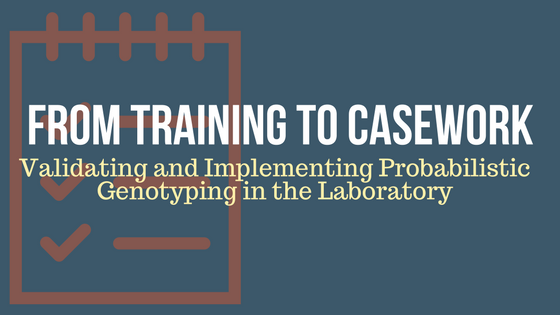Validating and implementing new technology can often feel like a daunting task. At DNA Labs International (DLI), staying on the forefront of DNA testing is critical to being able to offer new techniques that may be able to obtain results for those previously unsolved cold cases. However, like other laboratories, resources such as personnel and instrumentation have to be balanced with active casework deadlines. Furthermore, prioritizing validation projects is often based on the current needs of the laboratory. In 2015, when DLI acquired a software license for STRmix™, it was clear that validation and implementation would be a top priority due to the obvious and immediate benefits it offered for the vast majority of casework.
Written by: Alicia Cadenas, DNA Labs International
DLI was able to send one senior DNA analyst, Rachel Oefelein, to the weeklong training offered by the developers, the Institute of Environmental Science and Research (ESR) and Forensic Science South Australia (FSSA), in San Diego. She was tasked with absorbing the information offered during that training in order to subsequently return and not only train the other senior DNA analysts at the laboratory but also recommend a testing plan to begin our internal validation…not an easy task! Any individual that has trained in probabilistic genotyping methods can attest to its complexity. At DLI, we often pride ourselves on our “rock star” team of analysts and serologists and Rachel lived up to that standard. At the laboratory, three additional senior DNA analysts, myself included, became our initial STRmix™ team who would undergo the internal training offered at our laboratory.
In addition to the training obtained prior to obtaining the STRmix™ license, the STRmix™ developers offer a comprehensive implementation and validation guide that served as an excellent resource in developing our internal validation testing plan. Shortly after beginning our internal validation, in June of 2015, the Scientific Working Group for DNA Analysis Methods (SWGDAM) also published their guidelines for probabilistic genotyping methods. In conjunction, we were able to come up with a testing plan that incorporated all necessary elements for validation.
With the data generated from our internal validation, we were able to set our parameters for our standard operating procedure (SOP) for STRmix™ analysis. One question that all laboratories ultimately face when implementing a probabilistic genotyping method in their SOP is when to utilize this software option versus previous DNA analysis methods. Should we transition to reporting a likelihood ratio (LR) for all statistical calculations, moving away from calculating random match probabilities (RMP) even for single source profiles? There are pros and cons to each. Reporting a LR for everything would simplify your report and testimony, only requiring explanation of one statistic. On the other hand, attorneys are familiar with RMP and for simpler cases in which an LR is not necessary, should we put ourselves in a position to have to explain an LR? In the end, as a private laboratory that needs to be able to offer different options to our clients, the answer was obvious. We would continue to offer RMP, modified RMP and even combined probability of inclusion (CPI) for straightforward two person mixtures above stochastic threshold, in addition to having the ability to generate an LR using STRmix™ for those DNA profiles that do not meet the standard for comparison utilizing previous DNA interpretation methods.
Related:
Prior to implementation, our team of STRmix™ analysts worked together to generate reporting protocols for casework. Among the decisions that had to be made was which LR to report as the STRmix™ output provides a traditional LR, a unified LR, a stratified LR as well as options for incorporating the factor of N! and an HPD interval. At DLI we decided to report the stratified LR whenever possible for casework, incorporating the major population groups utilized as well as related individuals, in order to simplify testimony. In addition to reporting the LR value, we also incorporated a verbal scale, utilizing the same verbal scale used by ESR. For LR’s that support the defense proposition, we decided to report 1/LR, eliminating the verbal scale equivalents for LR’s that are less than 1.
DLI initially validated STRmix™ with one DNA profiling system, the Applied Biosystems® Identifiler® Plus kit, going online at the end of 2015; however, we knew that by January 2017 we would need to shift to additional systems that incorporated the expanded short tandem repeat (STR) loci. Based on the experience gained from our first STRmix™ internal validation, we incorporated all of the necessary testing into the internal validation plans for the expanded kits that we had slated to bring online. In addition, based on the direct experience we gained from utilizing STRmix™ throughout 2016, including questions that were asked in depositions and testimony, issues that were raised in admissibility trials and the President’s Council of Advisors on Science and Technology (PCAST) report on forensic science in 2016, we focused on incorporating additional validation studies that could further address questions that were being posed. For example, extreme mixture proportions were evaluated more thoroughly and we incorporated a multi-laboratory study on five person mixtures to evaluate reproducibility in these types of complex mixtures.
As we move forward, our protocol will likely continue to evolve based on our casework experience, additional planned studies and the needs of the laboratory. As a result of upgrades to the STRmix™ software program that continue to be released, additional validation studies and/or performance checks will be needed as well. As probabilistic genotyping methods become the norm, shifting to only reporting LR’s may be the path forward. Regardless of what the future holds, the validation and implementation process that has shaped our current protocol is an invaluable foundation.
Requests for additional information can be made via:
ATTN: STRmix inquiry
WOULD YOU LIKE TO SEE MORE ARTICLES LIKE THIS? SUBSCRIBE TO THE ISHI BLOG BELOW!


